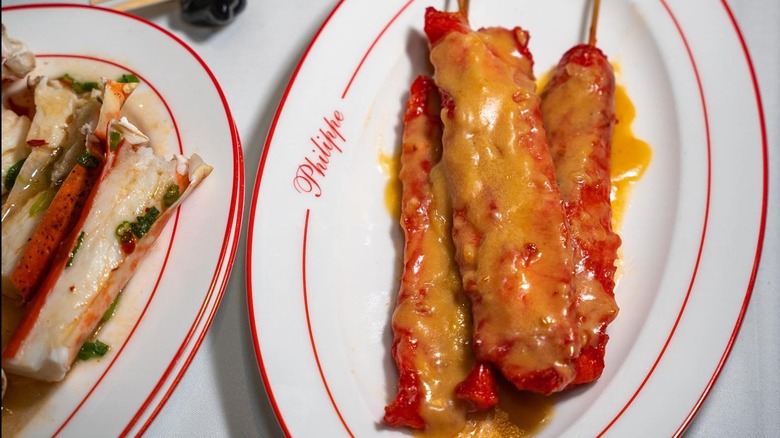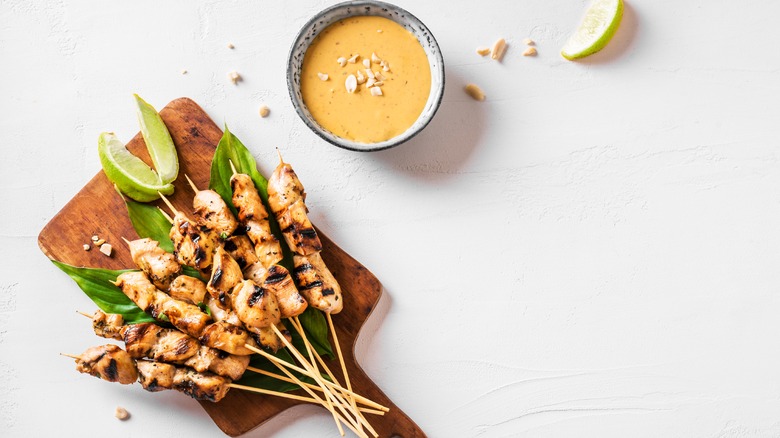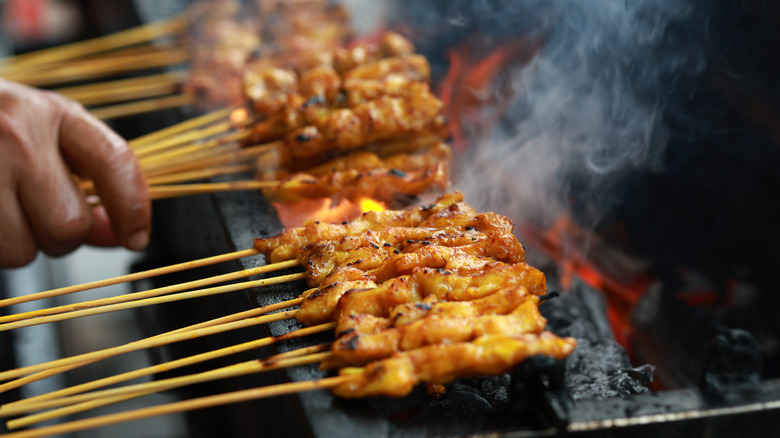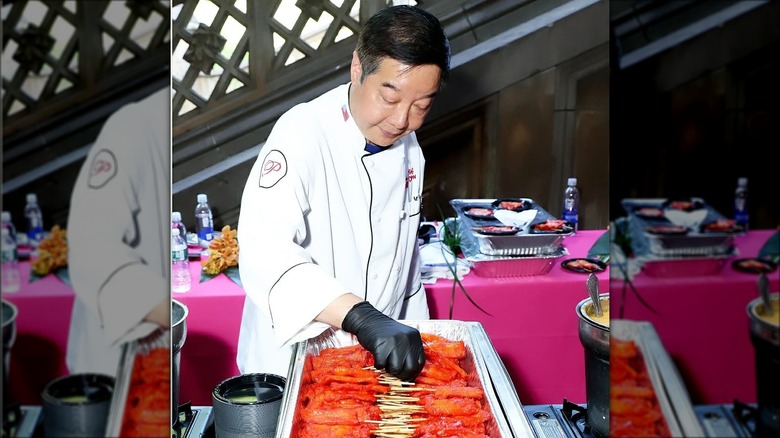Philippe Chow Shares The Secret To Mr. Chow's Iconic Chicken Satay
Chef Philippe Chow has been instrumental in bringing Beijing-style Chinese food to Western diners since 2004, when he opened Philippe by Philippe Chow in New York City and quickly transformed the Asian dining scene. Chow is known for many of his sumptuous culinary specialties, but his most iconic dish is his chicken satay skewers drenched in a vibrant peanut sauce. We recently connected with Chow, where he discussed the inspiration behind his chicken satay skewers and shared the culinary techniques he recommends for making flavorful, moist, chicken every time you enter the kitchen.
"The inspiration behind my iconic chicken satay skewers is a combination of my travels throughout Southeast Asia and my love for unique flavors," Chow notes. Unique Is perhaps the best word to describe Chow's chicken satay as his chicken is an eye-catching red color generously slathered with a thick orangey yellow sauce that is unlike any chicken satay we've encountered. For Chow, the sense that is most important in preparing his now-famous dish is olfactory. "The fragrant aroma [of my chicken satay] always reminds me of bustling night markets in Shanghai — I wanted to capture the essence of traditional street food but elevate it to a fine dining experience."
Chow's unique preparation for chicken satay
Chicken satay skewers have become a staple across many Chinese menus, but what makes Philippe Chow's chicken satay stand out from the skewers you've likely encountered at your favorite local Chinese restaurant? According to Chow: "What sets my version of chicken satay apart is the meticulous attention to detail in marination and the crafting of the peanut sauce." Peanut sauce is a popular condiment with roots in Indonesia that is prepared throughout the world and is made from a combination of ground roasted peanuts, water, and spices.
Chow's signature sauce includes lemongrass and a subtle touch of tamarind to increase the tanginess in the otherwise peanut-forward sauce. "We also incorporate coconut milk for creaminess and a touch of chili for heat," Chow adds. In order to allow the flavor to fully seep into the chicken, Chow marinates his chicken in a combination of coriander, lemongrass, and turmeric for 24 hours.
Trial and error to achieve perfection
Because chicken satay skewers can be found in so many different forms, you may be wondering how Philippe Chow landed on his now-renowned signature preparation. The answer is the key to most kitchen innovations: a process of trial and error to achieve the exact flavor profile that Chow was searching for. "My chicken satay recipe underwent several iterations," Chow reveals. "I spent months refining the balance of flavors, adjusting the marination time, and experimenting with the different cooking temperatures."
Determining the correct cooking temperature is one of the keys to ensuring that the meat you prepare will be evenly cooked, charred on the outside, but still moist and flavorful on the inside. When you cook chicken on too high heat, the chicken can quickly dry out, leaving you with a dense flavorless protein that is difficult to salvage even with the inclusion of a delicious topping.
The three most important tips for chicken satay
To try your hand at preparing chicken satay skewers at home, we've gathered Philippe Chow's three most important tips for replicating his recipe and ensuring that your chicken is tender and delicious. Chow breaks the recipe down into three parts: marination, even skewering, and creating the peanut sauce.
For the marination, Chow wants you to give your chicken ample time to marinate. He recommends 24 hours to achieve optimal flavor; if you're short on time, the general guidance is to ensure you have at least two hours to soak your chicken in marinade. According to Chow, "This not only infuses flavor but also ensures tenderness."
Chow's second tip is even skewering. Because the chicken that is prepared on a satay stick is smaller than a standard chicken breast or thigh, it's essential to monitor how each piece of chicken is cooking. To do this, Chow recommends making sure that "the chicken pieces on the skewer are sized similarly." This rule of thumb can be applied to cooking both animal proteins and vegetables because when ingredients are similarly sized, you'll achieve more consistency in how evenly they're cooked.
The third trick is all about the peanut sauce. Because the chicken is generously drenched in sauce, ensuring that your sauce is well-balanced is essential. To achieve this, Chow suggests using fresh ingredients and focusing your flavor profile on a balance of "sweet, spicy, and tangy."
Tips for cooking with chicken
Whether you plan to prepare chicken satay skewers or are just looking for some guidance on how to enhance your everyday chicken recipe, Philippe Chow has some helpful techniques for you. The first is to think about wet brining your chicken prior to cooking. Brining is a process of treating your protein with salt, which Chow believes is the key to ensuring your chicken will be tender. "A simple saltwater brine can work wonders to keep the chicken juicy," Chow notes.
The second tip is to make sure you have control over your heat. Chow recommends "avoid[ing] high heat for extended periods" to prevent your chicken from drying out. Instead, he encourages home cooks to "opt for a medium-high heat to sear and then reduce the heat to cook through." Searing creates that flavorful taste of charcoal that surrounds the tender chicken and gives it an amplified meatiness.
The third strategy may be the least familiar. Chow wants you to allow the chicken to rest after cooking. By taking just a few minutes off the heat after the chicken is prepared before serving, Chow believes you'll allow "the juices [to] redistribute, resulting in a moist bite."
Chow's recommended beverage pairing
Once you've mastered the art of chicken and are ready to sit down to eat it, you may be wondering: What is the proper drink pairing? For Chow's iconic chicken satay skewers, he believes the best drink to enjoy alongside the dish is a glass of Riesling. According to Chow, "The wine's fruity notes and slight sweetness perfectly complement the spices of the satay and the richness of the peanut sauce."
Riesling is a German wine that is known for its intense sweetness. That sweetness is often paired with dessert courses, but many wine enthusiasts agree with Chow that Riesling is underused. Drinking a glass of fruit-forward Riesling alongside a dish like chicken satay skewers helps to balance out the complexity of the tangy, creamy, and spicy dish by infusing a pop of sugary brightness. The flavor pairing may be surprising, but the taste is intensely refreshing.
500 chicken satay skewers
Before preparing your own chicken satay skewers at home, if you'd like to sample Chow's artistry, we recommend heading to Philippe by Phillippe Chow at either of its two Manhattan locations or visiting its outposts in Miami, Nashville, and most recently, Washington D.C. On an average day at Philippe by Philippe Chow, the kitchen prepares close to 500 chicken satay skewers. Chow shares that sometimes that number will be even higher. "Weekends and special occasions can see this number doubling!"
Want to make Chow's chicken satay skewers a staple at your next event? Chow also offers private event dining, which has been known to serve elite clientele such as NBA players at the Maddison Square Garden. For something a little less luxurious, but equally delicious, Chow's chicken satay skewers are also available to be shipped directly to your home from Goldbelly. In order to keep up with all of this demand, Chow shares, "Some days, we have several cooks overnight preparing chicken satay all night."






